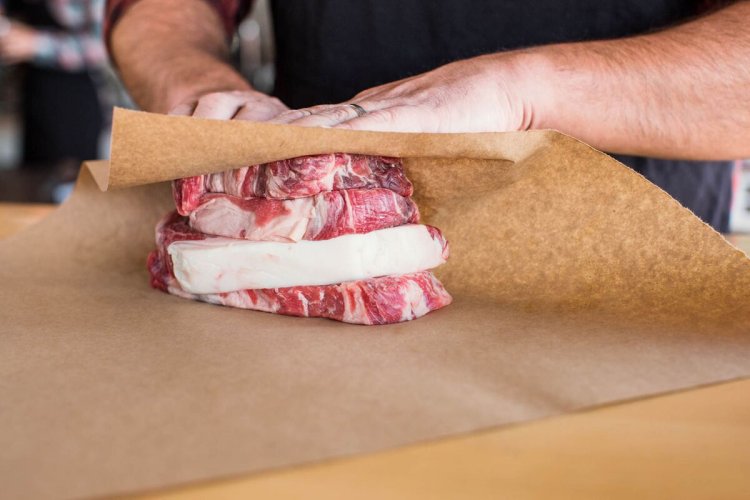Are Custom Wraps the Secret Behind Premium Meat Displays?
Butcher paper might seem old-fashioned. But there are solid reasons why it’s still a staple in meat counters, particularly custom versions tailored to each business.
Share this Post to earn Money ( Upto ₹100 per 1000 Views )

Walk into a high-end butcher shop, and you’ll probably notice more than just the marble countertops and glass cases. You might see beautifully wrapped cuts of meat in thick, rustic-looking paper stamped with the shop’s name. It’s not just about aesthetics. For many shops, custom wraps are becoming a signature part of how they present quality, build trust, and keep meat in top condition.
In a world where presentation can be just as important as flavor, the humble butcher paper has quietly become a branding tool and freshness guardian rolled into one.
What Makes a Meat Display Feel Premium?
It starts with the visual experience. Customers tend to associate good design with good quality. Whether it’s a clean counter layout, hand-written labels, or thick custom paper, every detail shapes how buyers perceive the value of the product.
When a customer sees meat wrapped in branded, grease-resistant paper—often with a vintage print or a logo that signals heritage—they’re more likely to view it as a premium product. That small touch signals care, consistency, and pride. It says: this isn’t just any piece of meat—it came from a place that values its craft.
But presentation isn’t the only function of wrapping. In the meat business, protection matters just as much. The right type of wrap helps keep moisture in, protects against contaminants, and prevents messes during transit.
Why Do Butcher Shops Still Use Paper?
In an age of plastics, printed butcher paper might seem old-fashioned. But there are solid reasons why it’s still a staple in meat counters, particularly custom versions tailored to each business.
Butcher paper is breathable yet strong. It helps meat retain its freshness without sealing in too much moisture like plastic wrap might. This makes it ideal for short-term storage and for handing over freshly cut meat to customers.
Many butcher shops also prefer paper because it’s eco-friendly. In a time when many customers are paying attention to sustainability, using paper over plastic can help create the kind of experience today’s conscious shoppers appreciate. And when that paper is branded, it adds another layer of thoughtful presentation.
Some butcher papers are also food-safe with special coatings to resist grease and absorb excess juices. Shops can choose options that reflect both function and brand personality.
The Custom Touch: Why Branding Matters
For small businesses and independent meat shops, branding matters more than ever. With supermarkets offering convenience and lower prices, local butcher shops rely on experience and trust to draw in customers.
That’s where custom wraps come in.
They’re not just decorative. They reinforce the shop’s identity. A well-designed logo or pattern, printed on every sheet of wrap, becomes a recognizable part of the customer’s experience. Over time, that recognition builds loyalty. Customers associate the branded wrap with quality service, clean handling, and flavorful cuts.
Think of how people react when they see a wedge of cheese in branded paper or a gift wrapped in tissue with a custom seal. It signals intention. The same idea applies to a T-bone steak tucked in butcher paper that proudly carries the shop’s name.
Do Wraps Really Impact Buying Decisions?
It might sound like a stretch, but yes—visuals can influence whether a customer makes a purchase.
Consider a display with no wrapping at all. The meat might look exposed, messy, or less cared for. Now compare that to neatly wrapped portions in clean, custom paper. Even if the meat is identical, the wrapped version feels more refined and safer.
This perception leads to higher customer confidence—and often, higher willingness to spend.
According to several small shop owners, custom wraps also help during holidays or peak seasons when they want to differentiate gift orders or seasonal specials. Instead of using plain white paper, they might use wraps with festive designs or personalized prints, adding value without changing the product.
And while wraps don’t directly improve flavor, they certainly help maintain freshness—especially if they're food-safe and designed to handle moisture, oil, and varying temperatures.
A Quiet Part of Customer Experience
In marketing, much is said about the importance of customer touchpoints. Butcher paper might not be the most obvious touchpoint, yet it plays a subtle, consistent role in how customers feel about a shop.
It’s part of the unboxing experience. When someone takes a wrapped steak home, peels back the paper, and sees clean, well-kept meat—it reinforces the feeling that they chose well. That moment, small as it is, adds to customer satisfaction. Over time, these small details help define a brand’s reputation.
And this idea isn’t limited to meat. Across the food world, the way items are wrapped or presented influences how people talk about them, recommend them, or post them online. Even in niche areas—like cheese, pastries, or seafood—custom food wraps play a role in storytelling.
Why Smaller Shops Lead the Way in Custom Design
Big grocery chains rely on plastic trays and standard wraps. But smaller meat shops often lead the way in custom design.
That’s partly because they know their customers more personally. They often serve repeat visitors who care about community, story, and service. Using custom wraps is one way to signal those values.
It’s also a low-barrier way to improve branding without overhauling the entire shop. A small investment in printed paper can help even a modest counter feel more upscale.
Some shops even rotate their wrap designs for seasonal promotions or limited-edition product runs. For example, one meat shop introduced a “farmer’s choice” line with custom food paper wraps featuring illustrations of local farms. The concept added character, sparked conversation, and led to higher sales without changing the cuts themselves.
Looking Ahead: Trends in Wrapping and Custom Prints
In 2025, custom butcher paper is seeing more creative uses. From QR codes printed on wraps that link to recipe pages, to biodegradable papers that reflect a shop’s eco-pledge, the options are growing.
Shops are becoming more design-savvy too. Some wraps feature illustrated maps of their region. Others use stamps or layered colors to hint at the meat’s source or preparation method.
Technology also plays a role. It’s easier than ever for businesses to order small batches of custom wrap, tailored to their exact size, texture, or branding. They don’t need to order thousands at a time—making it accessible for newer startups or specialty counters.
As the market gets more competitive, details like custom wraps help a business stand out. Not with gimmicks, but with quiet signals of quality, care, and story.
Conclusion: A Simple Detail with a Big Impact
Custom wraps might not be the first thing people notice when they walk into a butcher shop—but they often shape the final impression. From maintaining freshness to building a consistent brand, they play a more important role than most customers realize.
As more shoppers seek authenticity, story, and design in the food they buy, simple tools like branded butcher paper help meet those expectations. They offer a way to merge practicality with presentation. And for shops that want to feel local, handcrafted, and premium all at once—that’s a hard combination to beat.
If you’re a small meat shop, custom butcher paper , or food startup thinking about how to improve presentation without making huge changes, this could be one of the smartest places to start. A detail as small as the wrap might just be the thing people remember.
And when you're ready to design custom wraps that reflect your story, brands like waxpapershub are working with businesses across the food industry to create food-safe, memorable wrapping solutions that don’t just look good—they help you sell better.
















